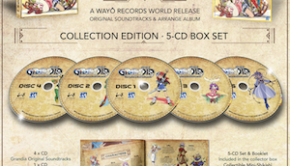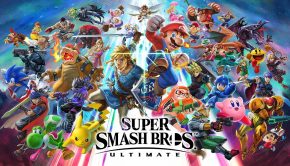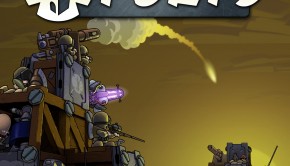Takahiro Nishi Interview: Sound Director at Game Arts
 Takahiro Nishi is the sound producer at Game Arts. During his time at the company, he has directed the sound for the Grandia, Lunar, GunGriffon, and Silpheed series. More recently, he has composed and arranged music for Super Smash Bros. Brawl, Project Sylpheed, and TMNT: Smash-Up.
Takahiro Nishi is the sound producer at Game Arts. During his time at the company, he has directed the sound for the Grandia, Lunar, GunGriffon, and Silpheed series. More recently, he has composed and arranged music for Super Smash Bros. Brawl, Project Sylpheed, and TMNT: Smash-Up.
This year, Takahiro Nishi produced Game Arts’ latest original title, The Magic Obelisk. He offered both an endearing spiritual story and innovative gameplay on the title. In addition, he developed a nostalgic and organic sound for its recently released soundtrack. In this interview, Nishi reveals his approach to The Magic Obelisk and his experiences working on Game Arts’ other eminent franchises.
Interview Credits
Interview Subject: Takahiro Nishi
Interviewer: Chris Greening
Editor: Chris Greening
Translation & Localisation: Marc Friedman
Coordination: Chris Greening, Noriyuki Iwadare
Support: Game Arts
Interview Content
Chris: Takahiro Nishi, many thanks for talking to us today. First of all, could you tell us about your background and introduce us to your career at developer Game Arts?
Takahiro Nishi: My mother always greatly enjoyed music, so from a young age I was brought up listening to Elvis Presley and the Beatles. Under their influence, I began to teach myself the electric organ and acoustic guitar — I think that was my first real experience with music. In school, I joined an ensemble and learned to read and write sheet music, and from there I joined a band with some friends. It was the 80s, so we styled our band over new wave and hard rock.
After graduating from university, I worked for a music company, where I arranged and composed. At that time, game hardware was graduating from PSG and FM sound sources to CD audio streams, leading to a greater power of expression in the medium. More than wanting to improve the quality of each composition on an individual basis, I wanted to match the music and sound of a project with each game. As a result, I felt the role of Sound Producer would be appropriate, causing me to start my career at Game Arts.

Chris: Your latest project is the WiiWare’s The Magic Obelisk. Could you please tell us about this title for those who have not heard of it? What features make it unique and appealing as a puzzle game?
Takahiro Nishi: The Magic Obelisk is a stage-based action game, where a tree spirit, Lukus, controls a light spirit, Popo. The tree spirits of the world go on journeys to find the perfect place to settle down and take root. Lukus has a dream, “Where should I become a tree?”, but whenever he leaves the shadows, he becomes rooted to the spot as a tree. The player must control Popo to manipulate the shadows throughout the stage, clearing obstacles and puzzles and guiding Lukus to the goal.
There are more than 30 stages in total. The opening ones act as a tutorial, easing the player in, but the game quickly steps up in difficulty, requiring the player to think to progress, and to act quickly.
Chris: On The Magic Obelisk, you served as a producer for the first time. How did you become appointed to this role? What were the unique challenges of this role, compared with that of composer or sound director?
Takahiro Nishi: This being Game Arts’ first original title in some time, we wanted to overflow the game with an originality unlike any seen before. It was a challenge to create a new game for the WiiWare platform, but it was a chance, and I stepped up to the task.
Becoming a game producer results in a larger scope of work, and I obviously would not have been able to do it all on my own. Game development requires a large, diverse team fulfilling a variety of roles, such as programming, design, planning, and communications, and I trusted them to their jobs. It was a big change from handling just the sound.
That said, with the greater proportion of work, it felt like a more significant experience when the title was completed.
Chris: Nevertheless, you were still responsible for composing the music of The Magic Obelisk alongside Keigo Ozaki. Could you discuss what inspired the calming approach to the music and how you integrated the soundtrack into the game?
Takahiro Nishi: I wanted to create a nostalgic feel for the music, to reflect the storybook atmosphere of a peaceful world in which there are spirits and animals to rescue, and to that end I utilized the oboe, clarinet and marimba.
Through “The World of Shadow,” the opening and ending theme, I tried to portray the feelings of the protagonist, Lukus, as he attempts to find a place to become a tree. The piano reflects Lukus’ continuous journey, which he undergoes step by step.
Additionally, from the beginning I wanted to imbue the game’s sound with the gamelan, an instrument from the Indonesian island Bali. The instrument offers a very genuine, pure sound, which I felt perfectly reflects the game’s image. In particular, I utilised the gamelan as the main instrument in the desert stage track “The Burning Desert”, to showcase the atmosphere of the edge of the world.

Chris: Looking further into your musical roles, you first composed for Tenka Fubu, Yumimi Mix, andSilpheed for the Mega CD. What did you offer to each of these projects and to what extent did they influence you as a musician? What technological opportunities did the console offer?
Takahiro Nishi: I participated in these three titles along with the rest of the staff. I wrote a number of compositions for both Tenka Fubu and Yumimi Mix, and I assisted with the recording for Silpheed. The use of the Mega CD was important in the sound direction of both titles.
I believe that games, being an interactive media, offer a special characteristic. Since the user has control over the game, the sound needs to change as time goes on. I want to express these interactive factors, and so I wanted to try producing game music on these initial titles.
Chris: You subsequently served as a sound director for the Grandia and series. Could you discuss how you developed a distinctive and immersive sound for this series? Were you responsible for many of the technological innovations, e.g. streamed music, associated with these titles?
Takahiro Nishi: The Lunar, GunGriffon, and Grandia series were the first that I was in charge of since coming to Game Arts. Lunar: Eternal Blue for the Mega CD was capable of streaming music, but the hardware of the time limited performance to a single channel — monaural. But since there was extra unused space in the monaural audio, we were able to create a faux stereo by shifting the streaming audio from left to right.
In Grandia, we wanted to infuse the music with a sort of three-dimensional feel, for the sake of portraying a playful breathing world inhabited by different characters, towns, and fields. For those means, we would vary the arrangement of the sound source on the 3D field. For instance, as the characters neared a water fountain, the music volume would gradually become lower as the sound of the fountain increased. The direction of the game system proceeded in this fashion.
We really troubled over the best way to give special recognition to the audio in each title. Not only was the portrayal of the music from the opening scene until the ending movie worked on, but all of the sounds of the environment were equally struggled over and perfected, going through countless cuts and edits, until we arrived at the perfect direction for the game.
Chris: Through your work on Grandia and Lunar, you developed a close relationship with Noriyuki Iwadare. Could you tell us more about how the two of you work together and how you influence each other’s work? Is it also true that the two of you have worked together on non-game projects, such as for the HAY Dance Company?
Takahiro Nishi: Noriyuki Iwadare remained consistent with the music of the Lunar and Grandia series. I would convey to him the atmosphere of the game, and he would create music that would reflect the game world.
He is like a music teacher to me, as well as a long time collaborator and friend. It had no relation to Game Arts, but I contributed music for HAY Dance Company, a musical group he directed. I invite you to please visit my website and listen to two tracks I composed at that time, “Led to the Moon” and “Solitude”.

Chris: Finally, you were responsible for the music of the newly released TMNT: Smash-Up. Could you describe how you developed a rocking approach for this title? Did the fact it is a licensed title influence your approach in any way?
I investigated how to properly convey the original world of TMNT to the user with this new title. The concept for the music was “Digital Ninja Punk,” which I tried to portray with a speedy rock approach. I used electronic beats and aggressive guitar work on most titles, but I also tried to implement a sadder, more melodic feel, in places.
Chris: Many thanks for your time today, Takahiro Nishi. Is there anything else you would like to say about The Magic Obelisk. Also, can you give us any hints about what to expect from you in the future?
Takahiro Nishi: The soundtrack to The Magic Obelisk is being distributed by the main site, free of charge, for English users here. Whether you play the game or not, I’ll be thrilled if you give the music a listen.
Unfortunately I cannot talk about the next title at this point in time, but I’m still trying to figure out the perfect sound for it. It’s a new challenge — I want to surprise the user and create something enjoyable. Please look forward to it!
Many thanks to Marc Friedman for translating this interview at short notice. Furthermore, thank you to Takahiro Nishi for his extensive discussions about the interview. Additional thanks to Noriyuki Iwadare for kindly introducing Takahiro Nishi to the site and the rest of the team at Game Arts for their cooperation.
Posted on March 7, 2010 by Chris Greening. Last modified on May 21, 2014.














